Electrical energy became essential commodity in the present day lively hood. There is a rapid demand for its generation both by conventional and renewable energy recourses. To address the environmental concerns and for overall economic development of the country, addition of major renewable sources of energy and transition from conventional energy systems to those based on renewable resources became necessary. Among several renewable energy resources, solar is identified as the main source for reliable power generation. In terms of cost of energy photo voltaic solar plants located in high solar radiation zones will have a greater economic and logistical advantage. In India about 58% of total land area (1.89 million km2) receives average Global Horizontal Incidence (GHI) above 5kWh/m2/day and can generate at least 77 W/m2. Andhra Pradesh State is one of the suitable locations in India for installing solar power plants due to the availability of about 300 sunny days in a year with solar insolation of about 5.5 to 6 KWh/m2/day. The proposed paper presents feasibility and energy yield analysis for a 5 MW photo voltaic based solar plant that can be erected at Rentachintala, one of the solar hotspot regions in Andhra Pradesh. This may attract investments and independent power producers for the establishment of solar power plant at that area and to some extent meets the objective of Indian solar power policy.
Keywords |
| Solar insolation, Photovoltaic, Poly crystalline technology, Energy yield. |
INTRODUCTION |
| One of the important components of India’s energy planning process is renewable energy. The importance of transition
of renewable energy sources to a sustainable energy base was recognized in the early 1970s. In this connection
Department of Non-Conventional Energy Sources was established in 1982, which was then upgraded to a full-fledged
Ministry of Non-Conventional Energy Sources (MNES) in 1992 and subsequently renamed as Ministry of New and
Renewable Energy (MNRE) [1]. Resource-wise targets have been formulated by MNRE for the period 2011-17,
keeping in view the estimated total potential, the progress made so far, the targets that were set for the 11th plan period
& corresponding achievements and the general constraints in different sectors. Table 1 shows year-wise targets for
grid-interactive solar power for the period 2011-17. |
| Renewable Energy Certificate (REC) mechanism was introduced by Central Electricity Regulatory Commission
(CERC) to ease the purchase of renewable energy by the state utilities and required entities, and also to create a
national level market for renewable power generators to recover their investment. Under this mechanism a power
producer can generate electrical energy in any part of the country through the available renewable resources. He can
sell that produced power based on the number of units generated and the environmental aspect. For the generated units,
he can receive the cost equivalent to that from any conventional resource and for environment aspect he can receive the
cost depending upon the exchanges at the market determined price. The required entity can purchase these RECs from
any part of the country to meet its Renewable Purchase Obligation (RPO) compliance. Main objectives of the solar
power policy [2] are presented in table 2. |
| India receives annual sunshine about 2600-3200 hours, i.e., 7 hours/day. Indian solar hotspots cover 58% of the total
land area (1.89 million km2) that receives average Global Horizontal Incidence (GHI) above 5 kWh/m2/day. Regions
that receive GHI of 5kWh/m2/day and above can generate at least 77 W/m2 at 16% efficiency and even 0.1% of the
land area of the identified solar hotspots (1897.55km2) could deliver nearly 146 GW of solar electricity. Under
Jawahar Lal Nehru (JNN) Solar Mission 10000 MW was planned by 2017 and 22000MW by 2022. |
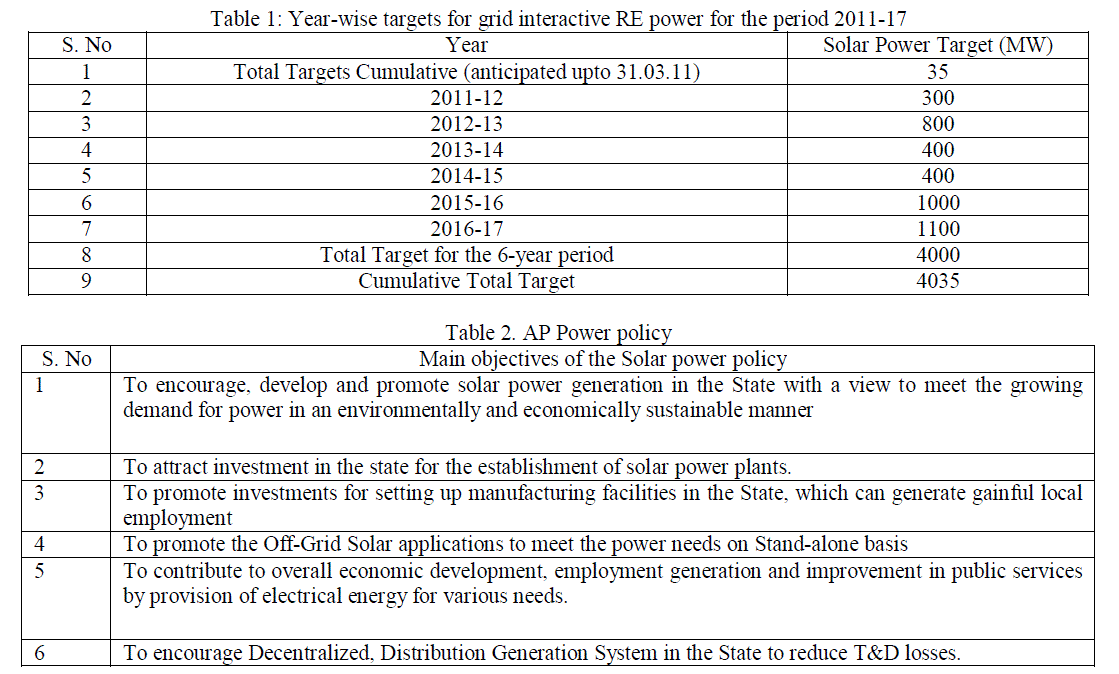 |
| In India, Andhra Pradesh (AP) state is one of the suitable locations for installing solar power plants [2]. In AP annual
sunny days are about 300, with solar insolation of 5.5 to 6 KWh/m². Power plants can be easily connected to the grid
due to the availability of widespread electric grid network and also due to growing energy demand in the State. |
PHOTOVOLTAIC (PV) TECHNOLOGY |
| Photovoltaic (PV) technology is a solar power technology that is developed based on Photovoltaic effect, discovered by
Becuerel in 1839. PV technology uses solar cells to convert sunlight irradiated directly into electricity without any
emissions. As on now, PV technology established, itself as a best, flexible and long term solutions for electrifying
poorest rural areas of the world. Solar cells are made of semiconductor materials. In solar cells, an electric field is
developed within a thin semiconductor wafer existing between a positive type layer (Boron doped) on one side and
negative type layer (Phosphorus doped) on the other side. When light energy strikes the solar cell, electrons will be
knocked loose from the atoms in the semiconductor material. If electrical conductors are attached to the positive and
negative sides, forming an electrical circuit, the electrons can be captured in the form of an electric current and can be
then used to power a load. The solar cell generates voltage about 0.5 to 0.6V DC under open circuit condition. Silicon
is the basic raw material for the PV industry. |
| The primary source of silicon is quartzite, which is found in the ordinary sand. Solar cells are grown on silicon wafers.
The thickness of the wafer decides the cost of a solar cell. Silicon will be purified, melted, and crystallized into ingots.
The ingots will be then sliced into wafers to make individual cells. The Indian PV industry now makes use of silicon
wafers in the thickness range of 210-240 microns as against 350 microns till a few years back. |
| Lot of energy is to be incurred in making a pure silicon wafer thus creating very expensive market for pure silicon
material. So, continuous efforts are to be incurred in developing a PV technology, particularly thin film technology,
that uses a very little or no quantity of expensive silicon. Thin film modules are fabricated by depositing very thin
layers of photosensitive materials on a low-cost backing. Substrates used for this purpose will be made of glass,
stainless steel or even plastic, which are inexpensive. Commercially available thin film types are amorphous silicon, cadmium telluride and copper indium diselenide. Table 3 shows the available solar cell and module efficiencies [3] and
fig. 1 shows spot PV module price trends in Europe. At present crystalline cell technology is the most dominant PV
technology. |
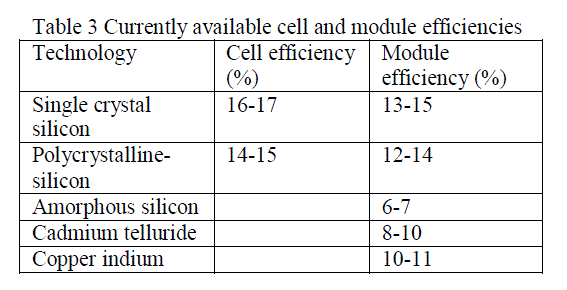 |
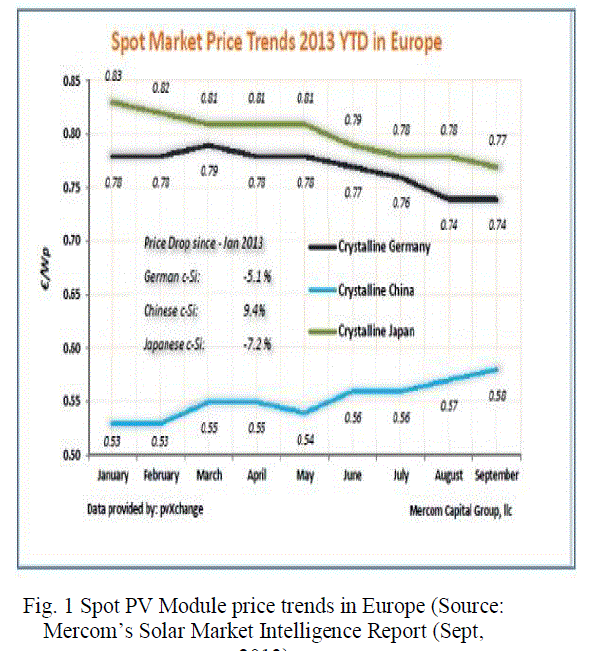 |
MAJOR COMPONENTS OF SOLAR POWER GENERATING SYSTEM |
| PV module is the basic component of a solar power system (SPS). Solar cells are building blocks of a PV module. All
components in the SPS, other than the module are termed as Balance of System (BoS). The BoS of a grid connected
solar PV system generally comprises Power Conditioning Unit (PCU) referred as inverter compartment, mounting
structure, AC and DC cables, earthing material, junction boxes or combiners, String Monitoring Box (SMB), weather
station, instruments and protection equipments. However the final configuration of a PV SPS normally depends upon
the location of the site and specified load requirements. |
| A. String Monitoring Box (SMB) |
| PV strings are connected to SMB. SMB consists of string connection compartment, string monitoring compartment and
main inverter compartment. |
| B. Weather Station |
| It consists of pyranometer for measuring solar radiation, temperature sensor for measuring ambient temperature,
humidity & air pressure, rain gauge for measuring rain fall inside the plant, anemometer for measuring wind speed &
wind direction , polycrystalline solar panel for charging 12V Battery and RS232 to RS 485 converter. |
| C. Inverter and its Components |
| It converts the DC power to AC power. It is made of Insulated Gate Bipolar Transistor (IGBT). It has high current, low
saturation voltage capability and self grid synchronizing capability. It is provided with overload, heat sink over
temperature protections. It is facilitated with auto run & auto shutdown features. |
| D. Other Components |
| Grid monitoring device is used for monitoring of voltage, frequency, and phase failure and phase sequence. It is
connected at output of AC breaker. Earth Fault Locator (EFL) monitors the insulation resistance of grounded PV
generator, DC cable and internal wiring. It has memory to store alarm massages with date & time and RS 485 interface
for data exchange. It is provided with Iso-meter disconnecting relay for the operation of multiple A-isometer in coupled
floating systems. Electro Magnetic Compatibility (EMC) Filter eliminates the electromagnetic interferences to protect
other electronic or electrical equipments. It is connected before the IGBT inverter. Sinusoidal Filters are low pass
filters that convert inverter pulse width modulated (PWM) voltage to sine wave. It suppresses the high frequency
components from inverter output. It is connected at output of IGBT inverter. Line Reactor reduces the harmonic
distortion and burden on upstream electrical equipments. It aabsorbs the line spikes and adding sags, prevents
overvoltage and under voltage tripping problems. It reduces the interferences with the electronic equipments |
GRID CONNECTED SOLAR PV POWER PLANT AT RENTACHINTALA-A CASE STUDY |
| Rentachintala is one of the best hotspot regions in Andhra Pradesh, with a daily horizontal surface solar irradiation
incidence between 5 and 6 kWh / m2. The Solar PV Power Plant (SPVPP) with proposed capacity of 5MWp will be
connected to the nearby grid for feeding generated power. The proposed grid connected SPVPP would be a
demonstration project to exploit renewable energy and analyse various aspects of plant operation. |
| The energy yield forecasting involves sourcing of average monthly global horizontal irradiation; wind speed and
temperature data from a variety of sources from land based meteorological stations. NASA –SSE Satellite data (1983-
2005) is considered for this case. The other tasks include calculating the global incident radiation on the collector plane,
estimating the losses that may occur during the power production process. This step uses PV module characteristics [4],
inverter specifications [5] and the site geography. Owing to the relative economy and availability in the market poly
crystalline PV module is considered for the energy yield estimation. |
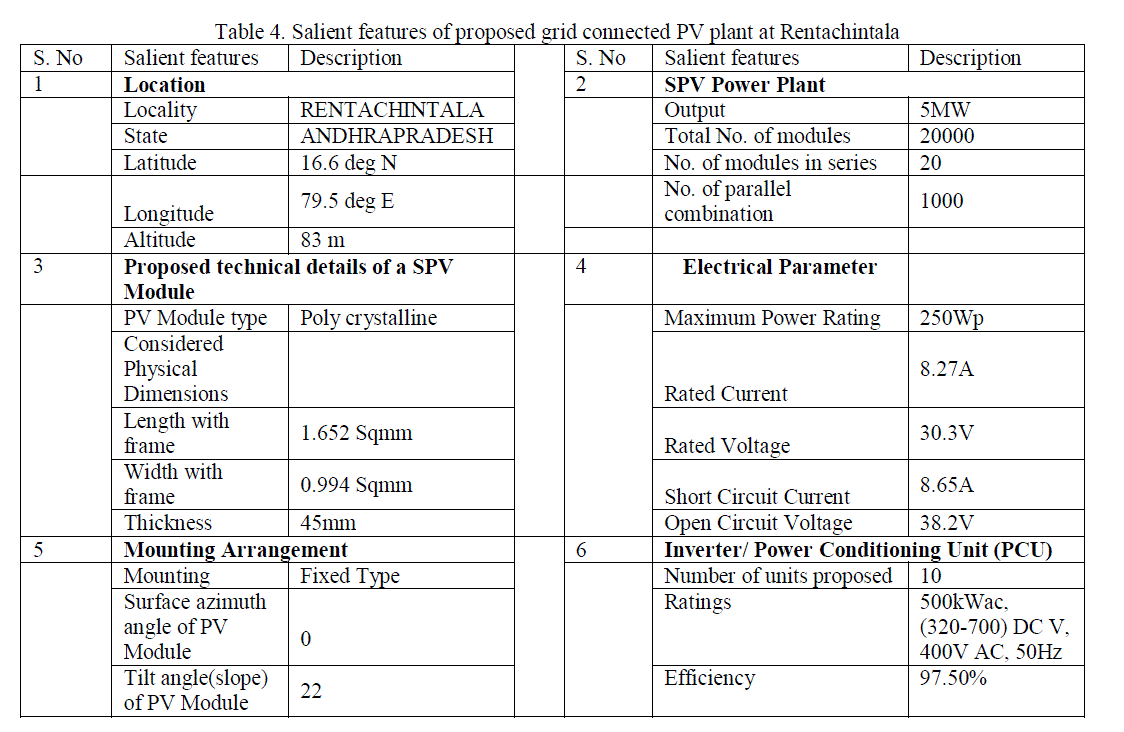 |
RESULT AND DISCUSSION |
| The possible energy generation at Rentachintala for 5 MW SPVPP is estimated using PV SYST V6.10 simulation
software. PVSYST is a photovoltaic simulation software that simulates the energy yield considering site resources, PV
module, Inverter and mounting structure specifications. |
| The proposed grid connected SPVPP at Rentachintala, Guntur District, Andhra Pradesh State would utilize vacant area
of about 101172 Sqm. The SPVPP is estimated to cost Rs. 30.60 Crores based on the normative cost of Rs.6.12Crores
per MW adopted by CERC Suo-motu order dated 7th January 2014 [6]. The tariff for sale of electricity has been
worked out adopting the parameters given in the CERC notification and energy generation as presented in this report.
Adopting normative cost estimate and capacity utilization factor, the levellised tariff works out at Rs 6.99 per kWh.
Salient features of proposed grid connected SPVPP at Rentachintala are presented in table 4. |
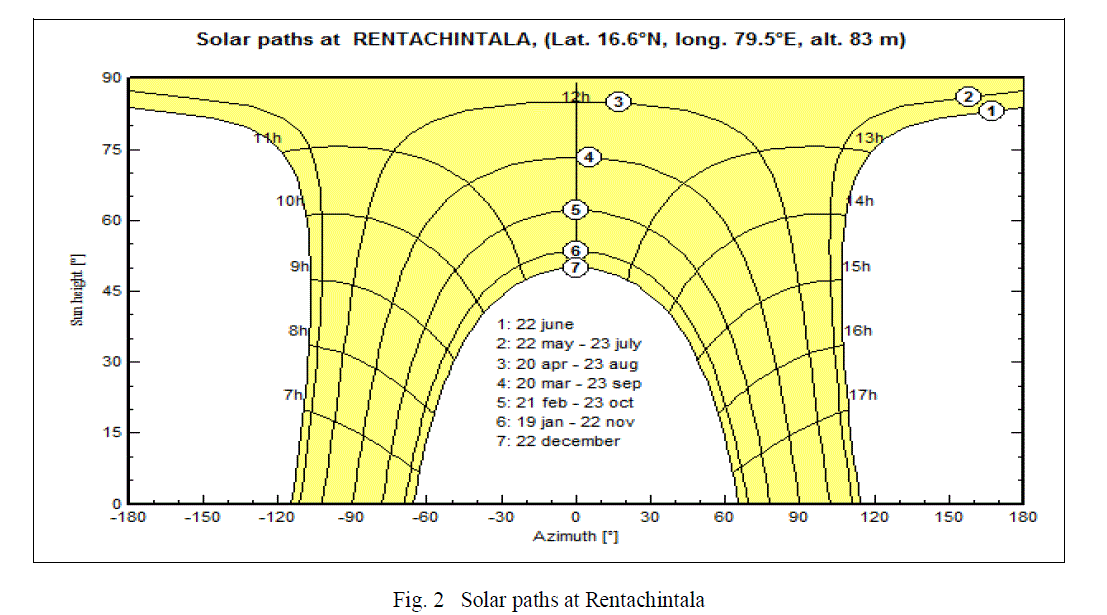 |
| Possible solar paths at Rentachintala, at latitude 16.60N and longitude 79.50E are depicted in fig. 2. |
| Fig. 3 shows the characteristics of 250Wp PV module and fig. 4 shows 500kWac inverter efficiency characteristics
considered for analysis. |
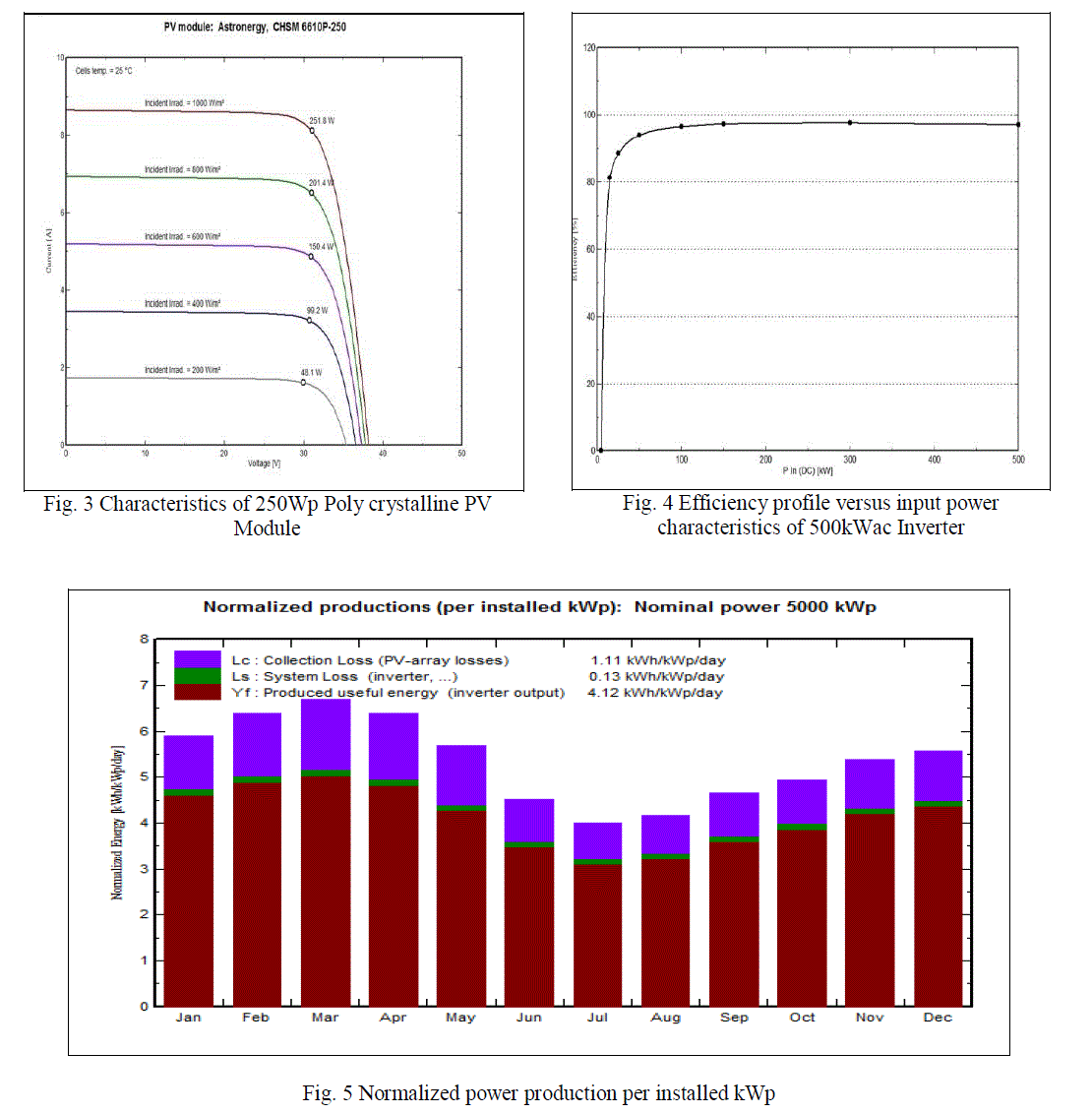 |
| In fig. 5 the net output energy at the inverter terminals is estimated as 4.2kWh/kWp/day considering the system loss
about 0.13kWh/kWp/day for proposed installed capacity of 5MWp. |
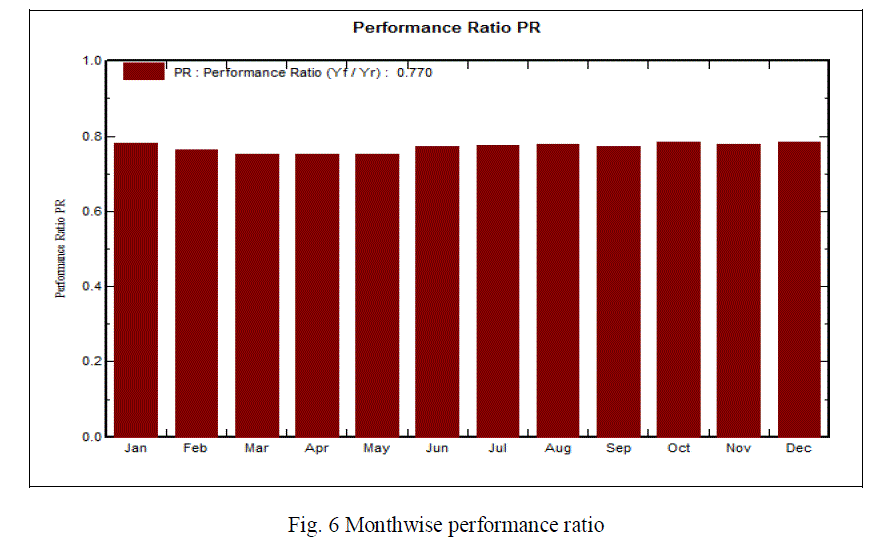 |
| From fig.6 average month wise performance ratio of the system is estimated at 0.770. |
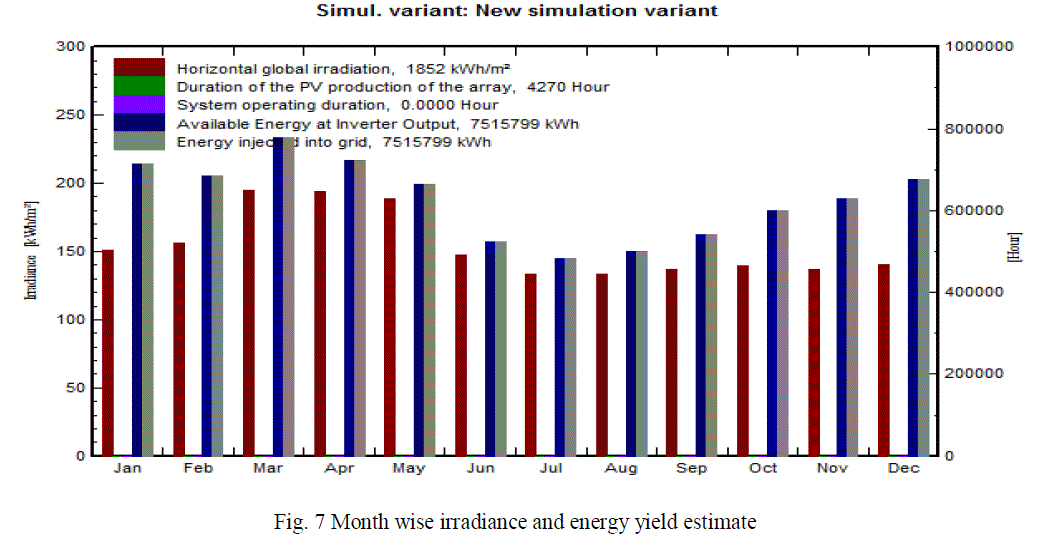 |
| Month wise irradiance and energy yield estimate is shown in fig. 7. The 5MWp SPVPP is estimated to afford annual
energy feed of 7515799 kWh considering efficiency of the solar module as 15.34%, PCU as 96.8% and losses as 3%
in the DC and AC system. The plant would operate at an annual capacity utilization factor of 19%. The energy
available from the plant would vary from a minimum of 715.012 MWh during the month of January to a maximum of
779.438 MWh during the month of March. |
CONCLUSION |
| Based on NASA –SSE Satellite data (1983-2005) and using PV SYST V6.10 simulation software, the energy yield
analysis for 5MW PV Solar power generation was performed for geographical site Rentachintala, which is located at
latitude 16.60 N and longitude 79.50E at legal time zone UT +5.5. And it was found that, for a horizontal global
irradiation of 1852kWh/m2, duration of PV production of the array is 4270 hours with performance ratio about 77%.
The available energy at the inverter output which can be fed to the nearby grid is 7515799kWh with a specific power
production about 1503kWh/kWp/year. This much amount of energy, which can be generated by establishing 5MW
SPV plant at Rentachintala, to some extent shares the generation demand at Andhra Pradesh and meets the objective of
Indian solar power policy. In these context independent power producers willing to establish the said SPV plant, will be
encouraged by MNRE with REC Mechanism under the regulatory direction of CERC. |
References |
- Strategic plan for New and Renewable Energy sector for the period 2011-17, Ministry of New and Renewable Energy, Government of India, February 2011.
- Andhra Pradesh Solar Power Policy, âÃâ¬ÃËClean and Green Energy âÃâ¬Ãâdevelopment of Solar power in Andhra Pradesh,âÃâ¬Ãâ¢Government of Andhra Pradesh, G.O. Ms. No. 39, dated 26th Sept 2012.
- European Photovoltaic Industry Association, Greenpeace Solar Generation IV-2007
- Data sheets of 250Wp PV Module, Astronergy make with model Astronergy, CHSM 6610P-250
- Data sheets of 500kWac Inverter, Generic make with model Generic, 500kWac Inverter.
- Central Electricity Regulatory Commission, New Delhi, Suo-motu Order Petition No. SM/353/2013 & Petition No. SM/354/2013, dated 7th January, 2014.
|